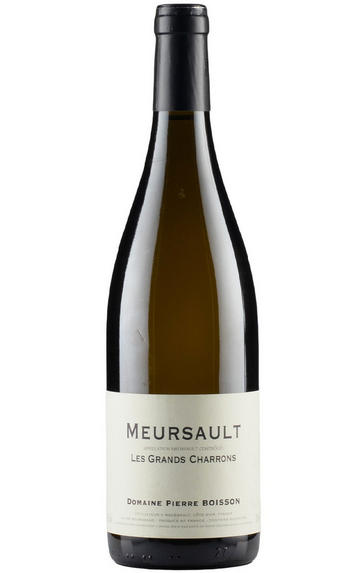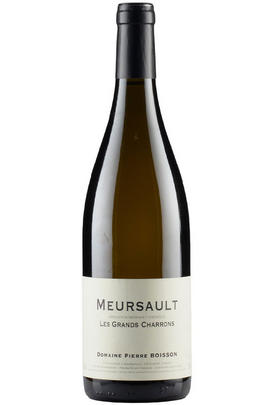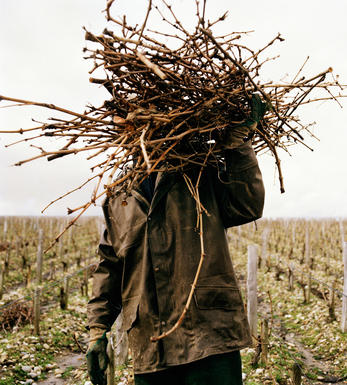
2018 Meursault, Les Grands Charrons, Pierre Boisson, Burgundy

Critics reviews
A lovely wine, the 2018 Meursault Les Grands Charrons opens in the glass with notes of pear, peach and apple blossom, framed by delicate hints of wheat toast and praline. Medium to full-bodied, elegantly textural and precise, it's built around lively acids and fine-structuring dry extract. This may not be the most long-lived rendition of this cuvée, but it's among the most immediately charming.
Once again, the bearded Bernard Boisson presided over my annual tasting in the usual, refreshingly old-school, manner, offering splashes from a variety of bottles, some open for several days and some opened for my benefit. As readers will remember, Bernard's holdings have been entirely divided between his son Pierre and daughter Anne, who work together in the vineyards and cellar, since 2017. As I've written before, in his day, Bernard Boisson was one of the village's latest harvesters; and his wines only spent a year on the lees, with much of the production sold to the négociants.
With Pierre's arrival at the domaine some 15 years ago, that changed dramatically: the domaine has returned, as Bernard puts it, to do things as they were done in his grandfather's era. That means early harvesting, little débourbage, long sur-lie élevage ranging from 19 to 22 months and restrained use of new oak—up to 30%, largely from Saint-Romain's Tonnellerie Gillet. The entire production is now bottled without filtration. This is a fine address, and this first look at the 2018s—as well as some later-released 2017s—revealed wines that are very much in the classic style that followers of these domaines have come to expect.
Drink 2022 - 2035
William Kelley, Wine Advocate (January 2021)
About this WINE

Domaine Boisson-Vadot
Domaine Boisson-Vadot, run by father and son team of Bernard and Pierre Boisson, is one of the rising stars in Mersault. The philosophy of the Domaine revolves around careful, hands-on vineyard management to coax the greatest potential of each vintage out of the various plots, and low-impact winemaking in the cellars that allows the unique terroir of each vineyard to surface. New oak is very minimal, no more than 30% for the top cuvées, and much more restraint in the village wines and in Bourgogne Blanc.
Pierre Boisson produces a village Meursault from his grandmother’s vineyards (50 year old vines in the lieu-dits of Criots and Perchots) that is hailed an model wine for the appellation. The Domaine also crafts other bottlings, from three of the best lieux à dits in Meursault: Sous la Velle , Grands Charrons (planted in 1988) and Chevalières (planted in 1982). The Grands Charrons is the most expressive, intensely flavoured of the three. The Sous la Velle is a more elegant version of the Grand Charrons. The Chevalières is the most mineral-driven, with a more restraint fruit flavours in its youth but great ageing potential- More like premier crus than village wines. Finally, Boisson-Vadot makes a powerful yet charming Meursault Genevrières premier cru.

Meursault
There are more top producers in Meursault than in any other commune of the Côte d’Or. Certainly it is the most famous and popular of the great white appellations. Its wines are typically rich and savoury with nutty, honeyed hints and buttery, vanilla spice from the oak.
Even though it is considerably larger than its southerly neighbours Chassagne and Puligny, Meursault contains no Grands Crus. Its three best Premiers Crus, however – Les Perrières, Les Genevrières and Les Charmes – produce some of the region’s greatest whites: they are full, round and powerful, and age very well. Les Perrières in particular can produce wines of Grand Cru quality, a fact that is often reflected in its price. Meursault has also been one of the driving forces of biodynamic viticulture in the region, as pioneered by Lafon and Leflaive.Many of the vineyards below Premier Cru, known as ‘village’ wines, are also well worth looking at. The growers vinify their different vineyard holdings separately, which rarely happens in Puligny or Chassagne. Such wines can be labelled with the ‘lieu-dit’ vineyard alongside (although in smaller type to) the Meursault name.
Premier Cru Meursault should be enjoyed from five to 15 years of age, although top examples can last even longer. Village wines, meanwhile, are normally at their best from three to 10 years.
Very occasionally, red Meursault is produced with some fine, firm results. The best red Pinot Noir terroir, Les Santenots, is afforded the courtesy title of Volnay Santenots, even though it is actually in Meursault.
- 305 hectares of village Meursault. The best vineyards include Clos de la Barre, Tesson, Chevalières, Rougeot, Narvaux
- 132 hectares of Premier Cru vineyards (17 in all). The finest vineyards include Les Perrières, Les Genevrières and Les Charmes
- Recommended producers: Comte Lafon, Arnaud Ente, Coche Dury, Guy Roulot, Jean-Philippe Fichet, Patrick Javillier, François Jobard, Michel Bouzereau
- Recommended restaurant: Le Chevreuil

Chardonnay
Chardonnay is often seen as the king of white wine grapes and one of the most widely planted in the world It is suited to a wide variety of soils, though it excels in soils with a high limestone content as found in Champagne, Chablis, and the Côte D`Or.
Burgundy is Chardonnay's spiritual home and the best White Burgundies are dry, rich, honeyed wines with marvellous poise, elegance and balance. They are unquestionably the finest dry white wines in the world. Chardonnay plays a crucial role in the Champagne blend, providing structure and finesse, and is the sole grape in Blanc de Blancs.
It is quantitatively important in California and Australia, is widely planted in Chile and South Africa, and is the second most widely planted grape in New Zealand. In warm climates Chardonnay has a tendency to develop very high sugar levels during the final stages of ripening and this can occur at the expense of acidity. Late picking is a common problem and can result in blowsy and flabby wines that lack structure and definition.
Recently in the New World, we have seen a move towards more elegant, better- balanced and less oak-driven Chardonnays, and this is to be welcomed.


Buying options
Add to wishlist
Description
A lovely wine, the 2018 Meursault Les Grands Charrons opens in the glass with notes of pear, peach and apple blossom, framed by delicate hints of wheat toast and praline. Medium to full-bodied, elegantly textural and precise, it's built around lively acids and fine-structuring dry extract. This may not be the most long-lived rendition of this cuvée, but it's among the most immediately charming.
Once again, the bearded Bernard Boisson presided over my annual tasting in the usual, refreshingly old-school, manner, offering splashes from a variety of bottles, some open for several days and some opened for my benefit. As readers will remember, Bernard's holdings have been entirely divided between his son Pierre and daughter Anne, who work together in the vineyards and cellar, since 2017. As I've written before, in his day, Bernard Boisson was one of the village's latest harvesters; and his wines only spent a year on the lees, with much of the production sold to the négociants.
With Pierre's arrival at the domaine some 15 years ago, that changed dramatically: the domaine has returned, as Bernard puts it, to do things as they were done in his grandfather's era. That means early harvesting, little débourbage, long sur-lie élevage ranging from 19 to 22 months and restrained use of new oak—up to 30%, largely from Saint-Romain's Tonnellerie Gillet. The entire production is now bottled without filtration. This is a fine address, and this first look at the 2018s—as well as some later-released 2017s—revealed wines that are very much in the classic style that followers of these domaines have come to expect.
Drink 2022 - 2035
William Kelley, Wine Advocate (January 2021)
wine at a glance
Delivery and quality guarantee